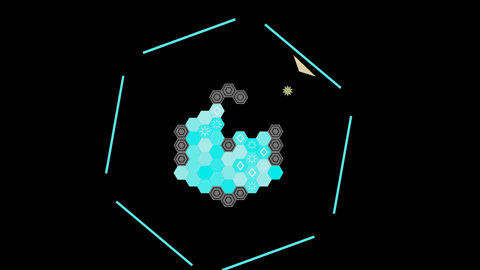Mondrian explores the crossover of a certain Dutch painter and videogame art

All art is, to an extent, the act of throwing your ideas at a canvas and seeing what sticks. In the case of Lantana Games’ Mondrian — Abstraction in Beauty, which is scheduled to launch in August, that description is simply more literal than it is figurative.
Mondrian is a classic block breaking game. You operate a gunship and hover around clusters of blocks—sometimes cubes; sometimes octagons—firing shots that explode and reshape the central cluster. The net result of this process is an abstracted image. All of this violence and commotion produces intriguing clumps of colored blocks, some of which are aesthetically appealing. One might therefore go so far as to say that Mondrian is a game about art.
Yet Mondrian is not a game about all art or even art as a general idea. Rather, it uses game mechanics to explore two very specific and interrelated ideas about art. Mondrian’s first proposition is that a game can “[take] an abstract look at the history of video game art” through the inclusion of a variety of mechanics and features that you have seen before, including “paddles, balls, powerups, and screen effects.” To those mechanics, Mondrian adds a new wrinkle to the traditional block breaking game by making it possible to hover around the central cluster and shoot from any angle. Mondrian’s use of old and new game mechanics to explore the history of videogame art suggests that a variety of games have also produced art of their own. This outcome may have been more incidental to the existence of earlier block breakers, but could still have existed as a side effect. Whereas a reasonable amount of videogame discourse is devoted to the question of whether games themselves are art, Mondrian suggests that we’d do well to consider the artistic value of fleeting moments within games as if they were stills.
No voxels or pixels needed.
Mondrian’s second proposition about art and videogames relates more closely to Piet Mondrian himself. Lantana Games claims to have been “inspired by the works of the De Stijl masters’ limitations on form and color.” This contention has a certain appeal. Games, like Mondrian’s most famous works, are really blocks of color within grid systems. The Dutch painter doesn’t need to have thought in terms of pixels and voxels for the parallel to function. Indeed, Mondrian’s claim that “by the unification of architecture, sculpture and painting a new plastic reality will be created” hardly precludes the existence of an evolving definition of art that might one day include that which is made in videogames.
That said, Piet Mondrian might not be the most apt artistic point of reference when thinking about Mondrian — Abstraction in Beauty. On the basis of their statements, Lantana Games appears to be building a game that suggests that one makes art as one plays a game. The violent cacophony of gameplay is that of the artist as well. In that respect, Mondrian’s preview footage looks a lot more like the work of Jackson Pollock. Violent collisions between objects take place, producing seemingly random results, but a broader artistic vision is at work. Throwing items at one another, be they paint at a canvas or a virtual ball at a block of bricks, can produce artistically compelling results. If Mondrian — Abstraction in Beauty manages to blend the wildness of Pollock and the abstracted grids of namesake, it will definitely be quite a sight to behold.
You can download Mondrian – Abstraction in Beauty on itch.io.



